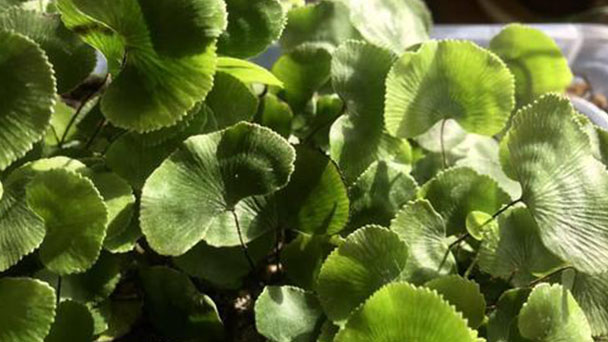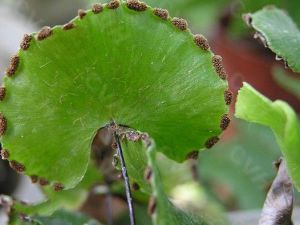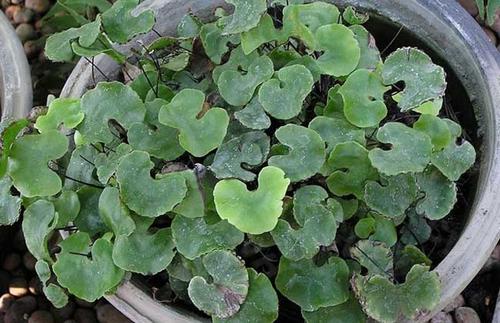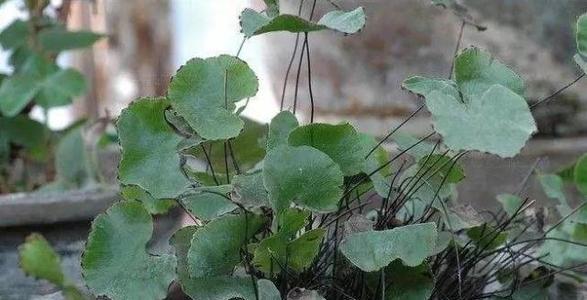Adiantum reniforme (lotus-leaved maidenhair fern) profile
Written by Maggie
Oct 29 2021

Adiantum reniforme , also known as lotus-leaved maidenhair fern, is a perennial ferns, 5-20cm tall. Rhizome is short and erect. Leaves are ellipsoreniform, 2 -- 6cm wide, dark green above, smooth, with 1 -- 3 homocyclic lines, sparsely brown villous below, margin with circular serrate, margin of long sporophylls curling back into pseudocysts. Adiantum reniforme divergences from fern reniforme about 4.94 million years ago.
Adiantum reniforme picture

Morphological characteristics of Adiantum reniforme
Adiantum reniforme is 5-20 cm tall. Rhizome is short and erect, apex densely covered with brown lanceolate scales and multicellular elongated pilose. Leaves are clustered, simple;Stole 3-14 cm long, 0.5-1.5 mm thick, dark chestnut, base densely covered with the same scales and pilose as on the rhizome, densely covered with brown multicellular pilose upward to the apex of the petiole, but easily wiped off when dry; Blade is round or round kidney-shaped, 2-6 cm in diameter, petiole birth place one or deep or shallow incision, on both sides of the hanging ear extension and overlap each other, sometimes leaves it around the petiole birth place, form 1 - three concentric circles, the edge of the blade with obtuse teeth, can education leaves due to the edge of the roll into false indusium teeth is not obvious, under the blade was sparse brown multicellular long pilose. Veins of adiantum reniforme radiate from the base to the periphery, more back to two branching, visible on both sides. Leaf dry grass green, natural death was brown, paper or hard paper. Capsula is rounded or sub oblong, upper margin flat, distributed along leaf margin, close to or spaced, brown, membranous, persistent.
Classification of Adiantum Reniforme
The general shape of this variety is similar to the fern Adiantum reniforme L from Madereira and Canary Islands in the Atlantic Ocean. It is very similar. Cytological study revealed that this variety is 4-ploid, which is exactly the same as the material produced in the Canary Islands, but different from the material produced in Madeira (which is 12-ploid), so the relationship between them needs further study.
Wang Aihua et al. (2015) studied the morphology, cytology, palynology and molecular biology of Adiantum reniforme (produced in China) and fern Nephrifera (produced in Canary Islands).Adiantum reniforme is a tetraploid fern, and Adiantum reniforme is a tetraploid fern.The spores of Adiantum reniforme have a smooth surface, while the spores of Adiantum reniforme have rough surface.The leaves of Adiantum reniforme are thin paper and have obvious concentric rings in shape. The leaves of Adiantum reniforme are thick leathery and resemble round or cattle-fan in shape without concentric rings.The molecular clock suggests a divergence of about 4.94 million years.
Ecological habit of Adiantum reniforme
Adiantum reniforme grows in patches on thin-soiled rocks and in crevices, 350 m above sea level. Adiantum reniforme is not only very different from this variety in appearance (the plant is stout, the scales are brown and opaque, the leaves are thick and leathery, and the leaves are densely covered with slender and interwoven white pubescence from petiole to leaf), but it is also 6-ploid, which is completely different from this variety in these aspects. Adiantum reniforme is usually grown on warm, wet, and unshaded soil, in crevasses, or grass. Light and air humidity are important for their growth; It likes shade and is afraid of light. Adiantum reniforme can not grow smoothly under strong light. It likes warm and humid environments, neither cold nor drought, and likes acid soil.
The community is mainly: the incense - oak - miscanthus community, salt-skin-iris community, water hemp - paniculate ascites grass community and Schizo japonicus - sea golden sand community; Adiantum reniforme is a companion plant in a community, hiding behind other plants because of its small size, and must wait until these plants have ceased to grow before growing slowly.
The distribution of Adiantum Reniforme
In the world, Adiantum reniforme only intermittent distribution in the east of Wanzhou District, west to Shizhu County Xituo District along the river nearly 100 km long, to the banks of 3 ~ 5 km deep in the narrow strip, the altitude is limited to 80 ~ 430 meters, but in the altitude of 170 ~ 250 meters between the more concentrated. (Find more indoor plants for low light here.)

Cultivation of Adiantum Reniforme
When potting, the pot can choose light glaze basin and earthen basin; The basin soil must have good permeability and aeration, generally with rich humus peat soil or leaf rot soil, and then add about 1/3 of the coarse sand and fine sand, and put some bone meal, and the basin bottom should pad some broken tile or coarse sand for drainage, rhizome planting depth of 1.5 ~ 2.5 centimeters.
Adiantum reniforme likes shade afraid of light, in the strong light can not grow smoothly, potted plants should be placed in the shade or shed under indirect light culture, summer avoid sun exposure.Water well during the growing season. Usually, Adiantum reniforme can be watered once a day, summer can be watered 2 times a day, and maintain a high air humidity; Summer high temperature season should also be a day to the leaf spray 2 ~ 3 times to maintain the leaf color green, but also put the basin in the water once a week to soak. After the end of autumn, should gradually reduce the number of watering, keep the basin soil moist, and enhance its cold resistance. When water is not enough, the leaves turn yellow easily.
But if the soil moisture is too saturated, or if the roots are too dry, the Adiantum reniforme will wilt and even die. The amount of fertilizer is not much, 15 ~ 30 days of liquid fertilizer can be applied once in the growth period, and nitrogen fertilizer can be applied topdressing in the seedling period. Do not contaminate the leaves with fertilizer when applying fertilizer, otherwise it will easily cause the leaves to wither and yellow and reduce the ornamental value. It has strong adaptability and fast growth. If the leaf cluster is too dense, Adiantum reniforme will lead to weak growth and yellow leaves. It should propagate or change the pot when it is needed. Adiantum reniforme likes calcium fertilizer, plants in the basin, can add a small amount of lime and broken eggshell to the basin, and supplement some calcium fertilizer. Too dense foliage is also not conducive to the germination of new leaves, can be in the autumn appropriate pruning, remove some old leaves, yellow leaves, in order to maintain the plant fresh and beautiful. The suitable temperature for growth is 18-25 ℃, and the overwintering temperature should not be lower than 10℃.
Propagation of Adiantum reniforme
1. Splitting propagation can be carried out indoors in all seasons, but it is generally carried out in early spring with potting. Remove the mother plant from the pot, cut off its rhizomes, so that each piece has part of the roots and leaves, and then plant in small pots. Around the roots and stems covered with mixed soil, irrigation and then placed in the wet environment culture, you can get a new plant.
2. Spore propagation method is: will be used as the substrate of peat and sand in the oven at high temperature disinfection, in order to kill bacteria and weed seeds. Then, put the sterilized soil into a shallow seeding pot. Cut off the leaves of Adiantum reniforme with mature spores, concentrate the spores and evenly spread them in the shallow sowing basin without covering the soil. Cover them with glass sheets, soak the water from the bottom of the basin, keep the soil moist, and place them in the semi-shade environment of 20-25°C. About one month, the spores can germinate into the proto leafs, and plant them after the basin is overgrown. Pay attention to one or two days before planting to remove the glass on the seeding pot for ventilation, so as not to cause plant rot or disease and insect pests. In addition, in a warm, damp environment, the spores spread easily and reproduce themselves.
Adiantum reniforme uses
Medical uses
Adiantum reniforme has the effect of "antipyretic and detoxification, diuresis and drenching".
The use of Adiantum Reniforme in gardens
Because the Adiantum reniforme is small, shade - loving, chic and beautiful, people will also be potted leaf plants. The fern is shaded, adaptable, easy to grow, more suitable for indoor perennial pot ornamental. As a small potted plant, Adiantum reniforme is better than asparagus in many aspects. Small pot can be placed on the desk, tea table; Larger potted can be used in order to decorate the windowsill of a shaded room, corridor or sitting room, and can offer a person a longer time to appreciate. The leaf is also a good material for leaf cutting and dried flowers.

Read Next:
Best 15 Indoor Plants for Low Light 2021
Latest Updated
- Benefits of Bugleweed - 7 Science-backed Health Benefits
- Bugleweed Dangers & Side Effects - Is It Poisonous?
- How to Plant Evergreen Trees - What You Should Know
- When to Plant Evergreens - Grow Guide for Evergreen Trees
- 12 Wonderful Evergreen Shrubs for Your Garden
- 12 Popular Evergreen Plants with Pictures for Beginners
- When And How To Prune A Lilac Bush Like a Pro
- How to Grow & Care for Lilac Vine (Hardenbergia Violacea)
- Japanese Lilac Tree (Syringa Reticulata) Care & Propagation Guide
- Shumard Oak Pros and Cons - What to Know
Popular Articles
- Winter maintenance of Antirrhinum Majus
- How to Grow Terminalia Mantaly Tree
- How to Grow and Care for Crossostephium Chinense
- How to grow Antirrhinum Majus in spring
- Peristeria Elata (Dove Orchid) Profile: Info & Care Guide
- Underwatered Snake Plant (Sansevieria Trifasciata) - Signs And How To Fix
- How to Care for Brazilian Jasmine Plant (Mandevilla Sanderi)
- How to Grow & Care for Graptopetalum Purple Delight in Summer
- Rosa Chinensis (China Rose): Plant Growing & Care Tips
- How to Care for Baby Sun Rose (Aptenia Cordifolia)